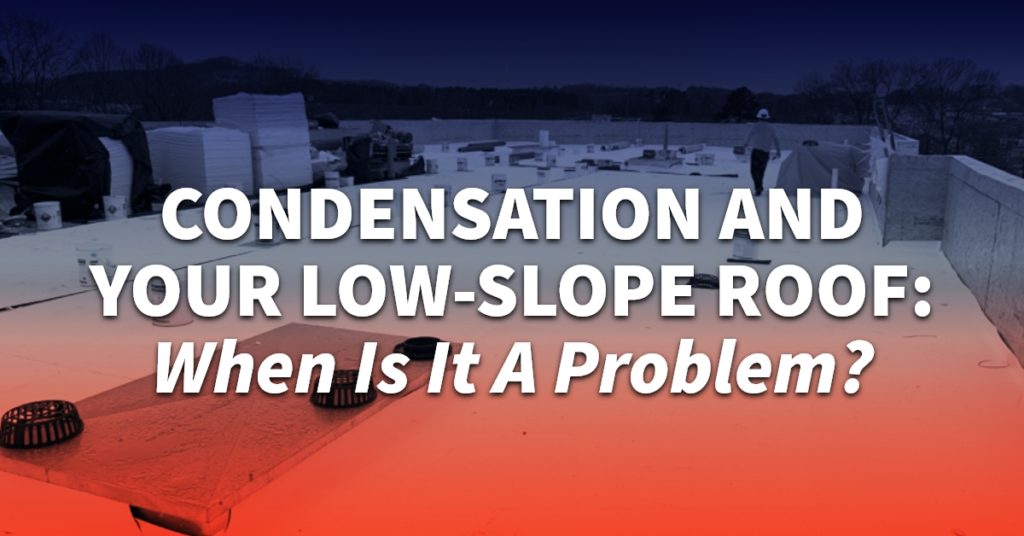Some things in life always seem to be paired: chocolate and vanilla; ups and downs; a low-slope roof and condensation. But sometimes, what you think is condensation within your roof deck could be a commercial roof leak. And sometimes, an apparent roof leak is only condensation. And that’s a problem!
Big Difference?
The physical evidence of a roof leak or condensation may not be vastly different:
- Dark staining on ceilings and walls
- Active water drips onto equipment or inventory
- Weakened drywall
- Mold or mildew accompanied by a musty smell
Both issues—condensation that drips into your building interior or a roof leak—result in irritating, unsightly, unpleasant problems. But a roof leak can be vastly more expensive to resolve—and require more specialized skills—than a condensation problem.
Localized
The easiest way to discern a condensation problem is to observe the location of the staining or water drips. Condensation can cause ceiling and wall stains in locations with unusually high humidity within your building envelope. These small, localized areas include:
- Kitchens and break rooms
- Laundry facilities
- Custodians’ slop sinks
- Employee shower and locker rooms
- Indoor pools and hot tubs
Anywhere warm, moist air is allowed to circulate, condensation can form on surfaces within your working space. Condensation can also occur within the roof deck:
- The underside of steel decking can provide the cool metallic surface needed for warm, moist air to give up moisture
- Gathered, condensed water droplets can then fall onto ceilings below the roof deck
Timed
Roof leaks, in contrast to condensation problems, are time-sensitive. If you see staining or active water infiltration immediately following any major precipitation, you probably have a roof leak. Low-slope roofs can also hold water for more than 48 hours, causing ponding, insulation compression, and clogged internal drains. This means the water damage from a roof leak will appear during a storm or heavy downpour and continue for up to three days.
Ponding, where rainwater collects and remains in place on your low-slope roof, is defined as water which does not evaporate or drain within 48 hours of falling. Ponding is a leading source of roof leaks.
No, No, No
Before you enthusiastically toss on a deerstalker cap and pick up a briar pipe to play roof detective, remember that no roof, of any slope, is safe for amateurs. Let the professionals solve the mystery of the dripping water. Keep your facilities crew off the roof as well.
Your trained, professional roofer can diagnose a roof leak or condensation problem with relative ease. Techniques include infrared cameras to sense water within the roof itself, core sampling, visual inspection, hands-on seam testing, and other methods.
When you turn to your highly trained commercial roofer, you pass the burden of detection and resolution on. You are safe from the fall risk inherent in roofing work, and you preserve your commercial building’s roof warranty. Stepping out on your own in search of the leak is unwise and could be costly.
Two Bad
Two bad conditions—condensation and roof leaks—both need to be addressed and solved for economic and aesthetic reasons. Condensation may not be as costly as solving a roof leak, but condensation definitely degrades the interior of your commercial property. Paint and metallic surfaces suffer. Drywall can become saturated and crumble. Constant high humidity is unpleasant for employees and customers alike.
Roof leaks not only can ruin inventory and supplies, but they can also cause electrical fires, endanger employees, and contribute to health problems related to mold and mildew.
Move It
Various methods are available to counteract condensation. Circulating air through your roof deck will move hot, humid air out and replace it with cooler outside air. Ensuring adequate rooftop insulation can prevent heat build-up, and completely separating your building’s interior air envelope from the roof deck also helps.
Inside your building, you can counteract condensation by using exhaust fans in high humidity areas, conscientiously keeping accessible surfaces dry, and regulating temperatures.
Roof leaks are more insidious than condensation problems. Unseen, a roof leak may work through your roof and into your roof deck over many months, drip by drip. Every day that passes drives up your costs, decreases your building’s value, and adds to your risk.
Your commercial roofer can determine if the roof leak has damaged structural members of the roof deck (rusted or corroded metal; rotten or broken timbers), saturated the rooftop insulation, or opened additional seams. With a roof leak, time is not on your side. You need to move fast and enlist your commercial roofer for prompt repairs.
Rackley Roofing is your best resource for all aspects of commercial roofing for your business in the southeastern United States. Contact us today to learn more about our extensive array of services, from commercial roof inspections to roof repair and complete roof replacement.



